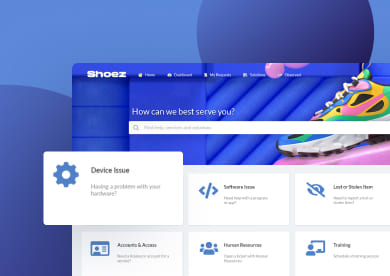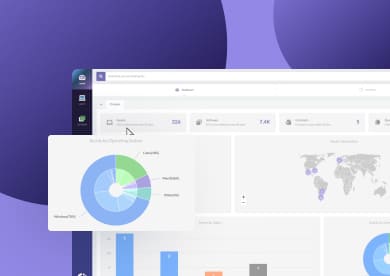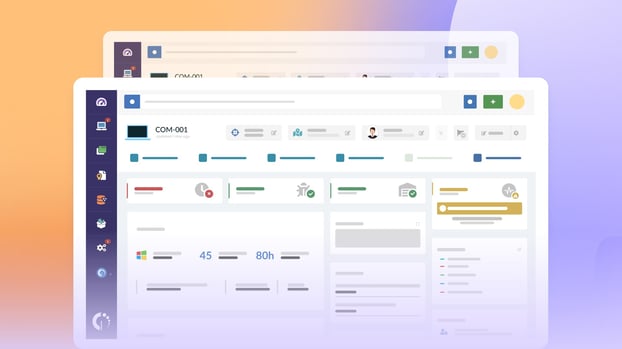Asset Management software for schools can make a big difference in both costs and operations. With 88% of United States public schools now providing each student with a school-issued device (National Center for Education Statistics), managing and protecting these assets has become a critical task.
This article explores why schools need dedicated Asset Management solutions, the challenges they solve, and what to look for when choosing one.
Why do schools need Asset Management?
Schools manage thousands of assets — from hardware like laptops, tablets, and projectors to software, contracts, licenses, and subscriptions.
As technology becomes a central part of every learning environment, having an Asset Management system to identify, track, monitor, and manage these assets is no longer optional. It’s essential to maintain control, accountability, and efficiency across all operations.
Main benefits of Asset Management software for schools
Implementing Asset Management in schools brings several advantages that directly impact their financial health, planning, and daily efficiency.
- Cost savings - Budgets in education are often tight, regardless of the level. Asset Management software for schools helps control acquisition, maintenance, replacement, and disposal costs. It also improves license management, preventing unnecessary renewals or compliance issues.
- Better planning through monitoring - Schools need to know where their assets are, who is using them, and what condition they’re in. This visibility enables smarter decision-making and better long-term planning for technology refresh cycles and maintenance schedules.
- Increased productivity - Teams that manage their school assets on a centralized platform gain complete visibility into their environment. This not only streamlines daily operations but also helps staff make faster, more informed decisions, improving overall productivity.
5 must-have features of asset tracking software for education
Implementing the right Asset Management tool in education starts with having the features that make visibility, control, and decision-making simple for IT and administrative teams. Here are the five essentials:
#1. Centralized inventory
Schools need a single, unified inventory where every asset is recorded and updated in real time — whether it’s an IT asset like a laptop, monitor, or keyboard, or a non-IT asset like a projector, lab microscope, or classroom desk.
The software should offer multiple population methods, such as automatic discovery, file imports, or integrations with other systems, to make sure no asset is left untracked.
#2. Comprehensive asset tracking
A strong school asset manager should support multiple ways to track assets, from installing agents on devices to monitor activity and health, to printing QR codes or barcodes for physical items.
Beyond location and ownership, schools should be able to monitor asset status, usage, cost, and depreciation, gaining full visibility into their value and lifecycle.
#3. Automated notifications and alerts
Automation saves valuable time and reduces human error. The system should automatically notify teams when assets need maintenance, when warranties are about to expire, or when devices go offline or are flagged as missing.
These alerts help prevent downtime, reduce losses, and keep operations smooth.
#4. Reports and custom dashboards
Data is key for informed decision-making. Schools should be able to generate detailed reports on asset usage, maintenance, and costs, and visualize trends through customizable dashboards.
This makes it easier to detect inefficiencies, plan budgets, and demonstrate accountability during audits.
#5. Integrations with Service Management tools
Integrating Asset Management with Service Management software creates a complete ecosystem for managing devices and requests.
When an issue arises, such as a damaged laptop or a missing projector, it can automatically generate a service ticket and link it to the corresponding asset record — improving communication and resolution times.
7 best Asset Management software for schools
Managing school assets (like student devices, computers, and classroom equipment) requires tools tailored to the unique needs of K‑12 environments.
Below we examine several leading Asset Management software solutions for schools, detailing what each is, why it’s useful for managing school assets, and what sets it apart.
| Tool | Pricing | Demo/free trial |
| InvGate Asset Management | Starts at $0.21/node/month. | Demo available upon request + 30-day free free trial. |
| Incident IQ | Quote-based (based on student count and modules). | No free trial. |
| Reftab | Free for 50 assets; paid plans from $30/month. | Free trial upon request + demo available |
| Wasp AssetCloud | Starts at $2,995/year (cloud); on-prem available. | No free trial + demo upon request. |
| BlueTally | Free for 50 assets; Starter plan from $99/month when billed annually. | Free plan (50 assets) + 14-day free trial. |
| VIZOR for Education | Quote-based. | No instant trial + personalized demo and trial upon request. |
#1: InvGate Asset Management

InvGate Asset Management is a dedicated IT Asset Management (ITAM) solution built to give organizations full visibility and control over their assets.
Its no-code, intuitive interface and automation features make it particularly effective for schools managing hundreds or thousands of student and faculty assets.
InvGate Asset Management features for school Asset Management
- Automated asset inventory - Automatically builds and updates a complete inventory of every school asset through multiple population methods, including network discovery, agent installation, file imports, and third-party integrations.
- Automated asset tracking - The InvGate Agent continuously monitors each device where it’s installed, reporting real-time data on condition, location, usage, and performance (among other things).
- QR codes for physical devices - For assets that can’t host an agent, InvGate Asset Management enables schools to generate QR codes for easy identification and tracking. Using the mobile app, staff can scan any tag to instantly access detailed asset information.
- Dashboards and reports - Customizable dashboards provide a quick, visual, and tailored view of all assets, allowing teams to monitor key metrics at a glance. Detailed reports complement this by supporting budgeting, audits, and lifecycle planning with accurate data.
- Extensive integrations - InvGate Asset Management connects with a wide range of tools to expand visibility and control. For example, it integrates with Google Workspace, Microsoft Active Directory, Google Endpoint Management, and Jamf School to centralize user and Device Management across ecosystems.
InvGate Asset Management pros
- Designed for education scalability — Works just as well for small schools as for large, multi-campus districts.
- Intuitive interface — Minimal training required thanks to a user-friendly, no-code environment.
- Transparent pricing — Clear cost structure with no hidden fees or user limits.
- Complete lifecycle management — Tracks every device from purchase through disposal, including financial data.
- All-in-one platform — Combines inventory, compliance, maintenance, and help desk in a unified ecosystem.
- Proven success in schools — InvGate Service Maangement has already been used by institutions like Harmony Public Schools with strong results.
InvGate Asset Management cons
- Asset-based pricing — Costs increase with inventory size, which may require license adjustments over time.
- Setup time for advanced features — Some integrations or custom dashboards may need initial configuration.
InvGate Asset Management reviews and comments
InvGate Asset Management has a 4.7/5 rating on Gartner Peer Insights, with reviewers consistently praising its flexibility and support.
User quote:
"Keeping track of our inventory is so easy now, and the product is very customizable. I love being able to add fields and automations whenever I want to. I do have a small issue with how conflicts are managed/resolved, but we're working through that. Customer service has been STELLAR."
Gartner Peer Insights
InvGate Asset Management pricing
InvGate Asset Management uses a subscription pricing model based on the number of devices ("nodes"). The official pricing structure includes:
- Starter plan — $0.21 per node/month (up to 500 nodes), billed annually (~$1,250/year)
- Pro plan — $0.38 per node/month (501–10,000 nodes), billed annually
- Enterprise plan — Custom pricing for larger deployments or advanced configurations
We provide a 30-day free trial to get you started with the product. No hidden fees.
#2: Incident IQ
 Incident IQ is a dedicated K–12 platform that combines IT Asset Management with help desk ticketing to streamline support and device tracking in schools. Designed by former educators and school IT staff, it directly addresses the unique needs of educational institutions.
Incident IQ is a dedicated K–12 platform that combines IT Asset Management with help desk ticketing to streamline support and device tracking in schools. Designed by former educators and school IT staff, it directly addresses the unique needs of educational institutions.
Its deep integration with Student Information Systems (SIS), learning tools, and one-to-one device programs makes it a smart choice for districts looking to consolidate asset visibility and support operations. What sets it apart is its all-in-one design, built specifically for schools (not adapted from corporate tools) which allows both teachers and IT teams to work efficiently with minimal training.
Incident IQ features for school Asset Management
- Rollout Scout for fast checkouts — Assign devices in seconds by scanning student ID and device barcodes.
- Integrated ticketing and assets — Every support ticket is linked to a specific device automatically, improving troubleshooting.
- SIS and classroom software integration — Syncs with student rosters and classroom tools for accurate user-device assignments.
- Inventory and Lifecycle Management — Track devices across their entire lifecycle, from distribution to retirement.
- Single sign-on support (SSO) — Makes platform access seamless for staff and students using Google, Microsoft, and others.
- Bulk actions for deployments — Allows IT staff to push changes or assign devices across entire grade levels or schools quickly.
Incident IQ pros
- Purpose-built for schools — Created by and for K–12 professionals.
- Highly intuitive interface — Teachers and non-technical users can easily navigate the system without formal training.
- All-in-one functionality — Combines asset tracking and help desk in one system, reducing the need for multiple platforms.
- Education-friendly pricing model — Costs scale based on student enrollment, not number of users or devices.
- Streamlined device programs — Features like Rollout Scout simplify and accelerate 1:1 deployments.
Incident IQ cons
- No free version available — Only paid plans are offered, with demos available upon request.
- Quote-based pricing — Requires schools to contact sales for a quote; no public pricing information available.
- Cloud-only — No on-premise deployment option for districts with strict data residency policies.
Incident IQ reviews and comments
Incident IQ is highly rated on education-focused software review sites, with a 4.6 out of 5 rating on Capterra.
"Easy to use and interface is simple. Customer service is great, freindly. The price also reasonable. I hope they will add more features to this software."
Capterra reviews
Incident IQ pricing
Incident IQ uses a quote-based pricing model based on:
- The number of enrolled students in a district.
- The modules selected (e.g., help desk, Asset Management, facilities).
This approach ensures affordability regardless of how many devices are being tracked. Pricing is not based on number of users or devices, making it especially cost-effective for schools with extensive one-to-one device programs.
- Free plan: Not available.
- Free demo: Available upon request.
- Free trial: Not offered publicly.
- Public pricing: Not available online (must request a quote).
#3: Reftab
 Reftab is an IT Asset Management and tracking platform built for simplicity and speed. It offers essential features like asset check-in/check-out, barcode scanning, maintenance tracking, and user request portals through a clean and modern interface.
Reftab is an IT Asset Management and tracking platform built for simplicity and speed. It offers essential features like asset check-in/check-out, barcode scanning, maintenance tracking, and user request portals through a clean and modern interface.
Reftab specifically markets itself to schools and IT departments looking for an easy-to-use system without the steep learning curve or high costs of enterprise solutions. It’s ideal for smaller schools or districts just starting with asset management.
Reftab features for school Asset Management
- Asset check-in/check-out module — Manage equipment loans and track who has what at all times.
- Mobile barcode scanning — Use iOS or Android apps to assign, locate, or audit assets on the go.
- User request portal — Allow staff or students to request equipment or report issues through a simplified interface.
- Maintenance and work order tracking — Log repairs and track the condition of each device.
- Custom fields and filters — Create school-specific tags for grade level, classroom, condition, or funding source.
- Role-based permissions — Control access for IT staff, librarians, or teachers depending on responsibilities.
Reftab pros
- Extremely easy to use — Simple setup and minimal training required.
- Budget-friendly — Lower pricing than most competitors, with a free tier available.
- Fast implementation — Schools can get up and running quickly without complex onboarding.
- Unlimited users — No user-based fees makes it flexible for school-wide use.
- Modern interface — Clean design that’s intuitive for both technical and non-technical staff.
Reftab cons
- Limited advanced functionality — May not be robust enough for large or complex school districts.
- Cloud-only — No on-premises version for schools with local hosting policies.
- Scaling limitations — Best suited for small to mid-size deployments; may lack advanced audit/compliance tools.
- Customization options are basic — Does not match the deep configurability of enterprise-grade platforms.
Reftab reviews and comments
Reftab is positively reviewed on platforms like Capterra, where it holds a 4.8 out of 5 rating. Users frequently highlight its ease of use and affordability, especially among school IT staff with limited time or resources.
"I have had a great experience with Reftab so far. Set up was easy with user friendly UI and support documents. The import tools were extremely helpful and the support team was phenomenal in helping answer questions and troubleshoot our Okta connections."
Capterra reviews
Reftab pricing
Reftab follows a transparent, asset-based pricing model:
- Free plan — Available for up to 50 assets.
- Starter plan — $30/month (up to 500 assets).
- Standard plan — Approximately $62.50/month for a higher asset limit.
- Unlimited users — Included in all plans.
There is a free trial.
#4: Wasp AssetCloud
 Wasp AssetCloud is an enterprise-grade IT Asset Management solution developed by Wasp Barcode Technologies. Known for its barcode and RFID hardware, Wasp brings decades of experience into AssetCloud — designed to manage thousands of assets.
Wasp AssetCloud is an enterprise-grade IT Asset Management solution developed by Wasp Barcode Technologies. Known for its barcode and RFID hardware, Wasp brings decades of experience into AssetCloud — designed to manage thousands of assets.
It supports advanced compliance, audit, and lifecycle tracking features that make it ideal for districts with high-volume inventories and strict reporting requirements.
Wasp AssetCloud features for school Asset Management
- Unlimited asset and location tracking — Centralizes inventory across multiple schools and departments.
- Funding source tagging — Track how each asset was purchased (grants, bonds, budget) for audit readiness.
- Audit and reconciliation tools — Schedule audits, perform barcode scans, and resolve discrepancies.
- Maintenance and work order module — Track repairs and service history across all school assets.
- Full Lifecycle Management — Monitor assets from acquisition to retirement, including depreciation tracking.
- RFID support (optional) — Add RFID scanning for fast mass check-ins or audits.
- Barcode hardware integration — Use Wasp’s proprietary scanners, printers, and labels for turnkey asset tracking.
Wasp AssetCloud pros
- Built for scale — Supports unlimited assets and multi-campus tracking under one system.
- Strong compliance tools — Excellent for districts with bond or grant funding requirements.
- Hardware integration — End-to-end solution includes barcode equipment and supplies.
- Cloud or on-premise deployment — Flexible hosting options based on IT policy.
- Extensive customization — Configure fields, reports, user roles, and workflows.
Wasp AssetCloud cons
- High cost — Pricing starts significantly higher than most education-focused platforms.
- Steep learning curve — More complex setup and configuration may require IT involvement.
- No free version — Only paid licenses are available, with trial access by request.
- Additional costs — RFID, extra users, or hardware accessories can increase the total cost of ownership.
Wasp AssetCloud pricing
Wasp AssetCloud is offered as both a cloud-based subscription and a one-time on-premises license:
- Cloud (AssetCloud Complete) — Starts at $2,995/year for 5 users, includes unlimited assets.
- On-premises (AssetCloud OP) — Starts around $6,995 (1 user) plus annual support (~18% after year one).
- Add-ons — Additional users, RFID, and hardware are extra.
- Free plan — Not available.
- Free trial — Available upon request.
- Demo — Yes, one-on-one demos and consultations offered.
Due to its pricing and scope, Wasp AssetCloud is best suited for large districts that need enterprise-level IT Asset Management capabilities with robust compliance and reporting requirements.
#5: BlueTally
 BlueTally is a cloud-based IT Asset Management platform that focuses on simplicity and affordability.
BlueTally is a cloud-based IT Asset Management platform that focuses on simplicity and affordability.
While it isn’t education-inexclusive, BlueTally is recognized as an excellent option for small K–12 schools, charter schools, or any institution managing a limited inventory. For schools transitioning from Excel for Asset Management, it provides a user-friendly and cost-effective upgrade that doesn’t require IT expertise to operate.
BlueTally features for school Asset Management
- Asset assignment and status tracking — Easily assign devices to students or staff and monitor status like "in use," "under repair," or "available."
- Audit logs and history — Maintain full records of asset movements, edits, and responsible users for accountability.
- Microsoft Intune and Jamf integration — Sync data from mobile device management tools used in school environments.
- Scheduled reporting and notifications — Receive periodic updates on asset status and upcoming deadlines.
- Unlimited assets (Starter plan and above) — Track large inventories without paying per-device fees.
- Simple and clean interface — Minimalist UI helps staff quickly learn and operate the system without training.
BlueTally pros
- Extremely budget-friendly — Offers a free-forever plan and low-cost entry-tier subscription.
- Ideal for small schools — Lightweight system that meets basic IT tracking needs without unnecessary features.
- Transparent pricing — No surprise fees or user-based charges; all plans include unlimited devices.
- Easy to implement — Schools can be up and running in minutes with no technical setup required.
- Web-based with mobile-responsive design — Works across devices without installing software.
BlueTally cons
- No mobile app — Lacks native iOS/Android apps, though the website is mobile-responsive.
- Cloud-only — Not suitable for schools requiring on-premise deployment.
- Limited advanced features — Does not offer built-in ticketing, audit compliance tools, or facilities management.
- Single-user free tier — The free plan supports only one user, which may limit school-wide collaboration.
BlueTally reviews and comments
BlueTally is well-rated on platforms like Capterra, where it holds a 4.6 out of 5 rating. Schools and small IT teams appreciate its simplicity, clean interface, and cost-effective pricing—making it a popular choice for those transitioning from spreadsheets.
"Started with a demo a couple months back, then finally got in a position to run the 14-day trial which really helped me sell the product to the rest of the team and then to upper management to get funding. Implementation is still a work in progress, but that Intune integration gives us a HUGE head start."
Capterra reviews
BlueTally pricing
BlueTally uses a freemium model:
- Free plan — Up to 50 assets and 1 user, available indefinitely
- Starter plan — $68/month (or $59/month if billed annually), includes unlimited assets and users
- Business and Corporate plans — Include advanced integrations, API access, and multi-tenancy (price by quote)
There is a 14-day free trial available (no credit card required). The transparent, flat pricing makes BlueTally one of the most accessible IT Asset Management tools for schools with limited budgets and simple needs.
#6: VIZOR for Education
 VIZOR for Education, developed by Vector Networks, is an IT Asset Management platform purpose-built for K–12 school districts. It supports the entire lifecycle of IT assets, particularly for one-to-one Chromebook and iPad programs.
VIZOR for Education, developed by Vector Networks, is an IT Asset Management platform purpose-built for K–12 school districts. It supports the entire lifecycle of IT assets, particularly for one-to-one Chromebook and iPad programs.
VIZOR is a Google for Education partner and includes features for asset tracking, student allocation, repairs, and optional help desk functionality—all designed around the specific needs of schools and districts.
VIZOR features for school Asset Management
- Chromebook and iPad tracking — Assign devices to students, track condition, and sync with Google Admin Console.
- Bulk import from SIS or Google Classroom — Import student and device data to streamline rollouts and inventory.
- Repair ticket tracking — Log device damage, repairs, and associated costs for accurate service records.
- Automated reminders and communications — Notify students/parents about returns, charges, or pickup info.
- Device disablement (via Google integration) — Remotely disable lost or stolen Chromebooks directly through the system.
- Warranty and insurance tracking — Link asset records to warranty status, insurance details, and failure trends.
- Integrated help desk (optional) — Manage support tickets and asset-related issues in the same interface.
VIZOR pros
- Built for schools — Education-specific features and workflows out-of-the-box.
- Full lifecycle coverage — Tracks everything from rollout and repairs to replacements and retirements.
- Strong Google integration — Syncs with Google Admin Console and supports Chromebook remote actions.
- Excellent onboarding support — Includes free setup, training, and tech support for schools.
- Centralized communication — Automates messages to students and parents, reducing asset loss and confusion.
VIZOR cons
- No public pricing — Requires contacting sales for a quote.
- No self-service trial — Personalized demo or trial setup must be requested.
- May be too robust for very small schools — Feature-rich system could feel excessive for schools with minimal needs.
- Help desk module is optional — Schools must request it explicitly if they want integrated support ticketing.
VIZOR for Education reviews and comments
VIZOR is well-reviewed by IT staff in K–12 environments, especially for its student-focused workflows and Google integration. On Software Advice and related platforms, it receives praise for simplifying complex Device Management processes.
"Working with Vizor was just like hiring an experienced IT colleague. I enjoyed working with barcode check-in/ out work flows, the good Active Directory integration, and the cost, purchase order and warranty reporting."
Capterra reviews
VIZOR for Education pricing
VIZOR is sold via annual license (subscription model):
- Pricing is quote-based — Varies by school/district size and module selection (e.g. whether help desk is included).
- Includes unlimited users and devices — No per-device or per-student fees.
- All editions include — Free setup, support, and training (no extra onboarding costs).
- Free trial — No instant trial, but schools can request a personalized demo and pilot environment.
- Deployment options — Available as a cloud-hosted solution or on-premises install.















